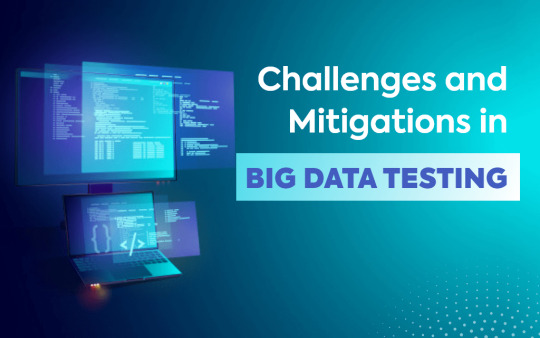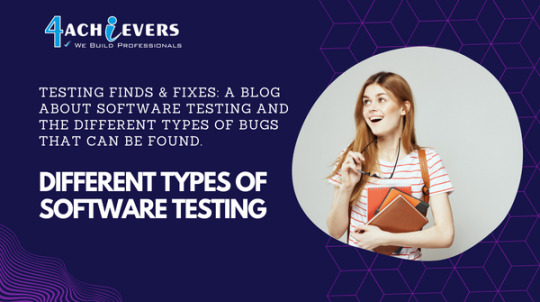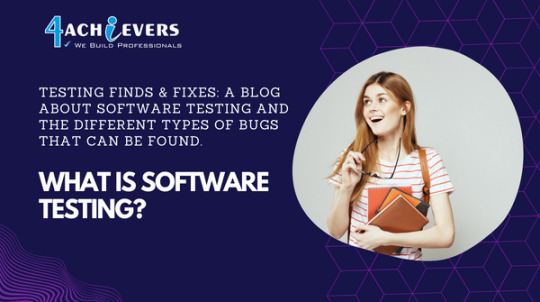#bigdatatesting
Explore tagged Tumblr posts
Text
Is Big Data Testing and ETL Testing the Same?
Big Data testing and ETL testing are related but serve different purposes. Big Data testing ensures the accuracy, performance, and scalability of large data sets, while ETL testing focuses on verifying the extraction, transformation, and loading processes in data warehousing. Both are crucial for ensuring data quality, but they address different stages of the data lifecycle in analytics and business intelligence.

#BigDataTesting#ETLTesting#DataQuality#DataAnalytics#DataTesting#BusinessIntelligence#DataWarehouse#DataManagement
0 notes
Text

#softwaretesting#manualtesting#sdet#functionaltesting#programming#whatissoftwaretesting#automation#testing tools#testing#postman#bigdatatesting#etltesting#softwaretestingmaterial#softwaretestingtutorial#softwaretestingtraining#webservices#soapui#rest assured#hadooptesting#integrationtesting#software#manualtestingtutorial#softwaretestingtutorialforbeginnersseleniumvideos#performancetesting#automation testing#regressiontesting#softwaretestingforbeginners#softwaretestingtypes#testingtutorial#softwaretesting lifecycle
0 notes
Text
How can Big Data Testing be Made More productive and Comprehensive

Big data refers to any collection of large data sets, both structured and unstructured, that is difficult to process using traditional data processing applications or software tools. With big data becoming integral to ensuring the quality of enterprise applications, businesses need to ensure it is collected, curated, stored, analyzed, retrieved, and managed properly. In general, big data is characterized by properties such as volume, velocity, variety, veracity, variability, and value. These properties are explained as under:
Volume: The sheer size of data
Velocity: The ability of a system to create and transmit the data
Variety: The various types of data
Veracity: The quality and integrity of data
Variability: The frequency of changes in data flow
Value: The benefit of data to the business
The importance of big data can be gauged from the fact that it offers enterprises critical insights about business trends, end-users, markets, and competitors. By enabling analytics, big data can help business enterprises make informed decisions. For instance, eCommerce companies can look into the search and sales patterns to understand the type of products customers look for and buy. Armed with this knowledge, they can work towards streamlining the placement and display of the specific product items in the catalog or shelves of the store.
Why test big data?
Big data testing is a process where a big data application is tested to determine whether its functionalities are performing as expected. Also, a big data environment may comprise a large volume and variety of data, complex algorithms, unstructured data layers, and complicated logic. And to ensure the accuracy, quality, and integrity of data across channels and sources, testing big data applications has become critical. The other benefits of big data testing are as follows:
Enables data-driven decision making in real-time.
Assures the accuracy of data based on which proper analysis can be done to identify and mitigate issues plaguing the business.
Optimizes business data to allow the delivery of best results.
Minimizes losses and increases revenues.
Enables businesses to achieve seamless integration, reduced quality costs, and time to market.
How to Improve Productivity and Increase Test Coverage.
It is only by following the best practices for big data automation testing that attributes such as productivity and test coverage can be improved. The components of big data testing are as follows:
Data validation testing: This type of testing ensures the accuracy and completeness of data, and verifies whether the collected data is corrupted or not. This is done in the Hadoop Distributed File System, or HDFS, where the data is partitioned and checked thoroughly. It is generally carried out on one or more data fields wherein it verifies whether the individual characters provided by the user as input are similar to the expected characters of data types as defined in a data storage mechanism. Data validation testing consists of four steps
Preparing a detailed plan about the expectations, the way to resolve issues, defining the iterations, and obtaining the required data for testing.
Validating the database by ensuring the applicable data is available and following the steps to determine the size of the data, number of records, and compare the source and target data.
Validating data format to ensure that end-users and the target system understand the data.
The sampling of data by testing a small amount to check if it meets the business requirements. It is only when the small sample is found to be correct that a large set of data is proceeded with for testing. This helps to increase the quality and accuracy of data and decrease the error rate.
Range and constraint validation: This testing process examine the user input for consistency by conducting a test to evaluate the sequence of characters or the maximum or minimum range.
Code validation: This includes tests for validating the data type and verifying whether the user input is consistent with the external rules, validity constraints, or requirements of the business organization. The other validity constraints may involve cross-referencing the data with a directory information service or a look-up table.
Structured validation: This type of testing allows you to combine any number of different data validation steps and complex processing. The complex processing here may include testing the conditional constraints for a set of processes within a system or for an entire data object.
Conclusion
With the exponential growth of big data characterized by exabytes, zettabytes, and yottabytes, it is of critical importance to check their accuracy, completeness, and integrity across channels. If done appropriately and by following best practices, big data testing can lead to better decision-making and success for organizations in the competitive world of business.
Resource
James Daniel is a software Tech enthusiastic & works at Cigniti Technologies. I'm having a great understanding of today's software testing quality that yields strong results and always happy to create valuable content & share thoughts.
Article Source: datafloq.com
0 notes
Text

With the rapid evolution of Big Data, there come several challenges such as bad data, system errors arising due to massive data, and multiple processing methods that can result in huge revenue loss. Our skilled #QAengineers ensure the quality of your data as well as the reliability of your big data processing.
0 notes
Text
Big Data Testing Using iCEDQ

While testing Big Data, one of the primary and foremost concern is the testing speed. iCEDQ Big Data Testing Tool uses various rules like Checksum, Cluster Validation, Cluster Recon, Validation, Recon, and Script rules to establish the integrity and validity of the data. It is not possible to test Big Data manually, so iCEDQ automates the Big Data Testing efficiently with the capability of testing any size of data.
It utilizes the Apache Spark Cluster to evaluate every rule or group of rules (Regression pack) efficiently. It uses parallel processing (Multithreading) to use all the available resources skillfully. You can use multiple connectors like Hive, Impala, Cassandra, MongoDB, HDFS, and many more.
0 notes
Text
Challenges And Mitigations In Big Data Testing
Big data testing needs to follow the same evolutionary cycle as that of software testing. To handle the dynamic nature of the advances in technology, organizations must think about how they manage the aforementioned three pillars. Read more: https://qainfotech.com/big-data-testing-challenges-and-mitigations/
#BigData #BigDataTesting #SoftwareTesting #Blog #BlogPost #QAInfoTech

0 notes
Photo

Performing a JOIN operation in HIVE #hdpcd #bigdata #bigdataanalytics #hadoop #hive #developer #bigdatadeveloper #bigdatatester #developerlife #studentlife #coder #milind #jagre #milindjagre (at Ford NA Learning & Development)
#bigdataanalytics#coder#hadoop#bigdata#bigdatatester#milindjagre#hdpcd#developer#developerlife#studentlife#jagre#milind#hive#bigdatadeveloper
0 notes
Link
Top 3 Disruptive Digital Trends in Retail You Need to Know https://t.co/OmwStBiTuS #bigdatatesting #mobileapplicationtesting
0 notes
Link
Top 3 Disruptive Digital Trends in Retail You Need to Know https://t.co/OmwStBiTuS #bigdatatesting #mobileapplicationtesting
0 notes
Text

#softwaretesting#manualtesting#sdet#functionaltesting#programming#whatissoftwaretesting#automation#testing tools#testing#postman#bigdatatesting#etltesting#softwaretestingmaterial#softwaretestingtutorial#softwaretestingtraining#webservices#soapui#rest assured#hadooptesting#integrationtesting#software#manualtestingtutorial#softwaretestingtutorialforbeginnersseleniumvideos#performancetesting#automation testing#regressiontesting#softwaretestingforbeginners#softwaretestingtypes#testingtutorial#softwaretesting lifecycle
0 notes
Text
Challenges Faced by Businesses and Mitigations in Big Data Testing

Data has become the new gold, as is often bandied about in the media. The remark is not off the mark as data has seen a phenomenal expansion with the level of IT tools being leveraged by businesses worldwide. It has certainly become the new frontier to be conquered or dealt with by companies that look to gain insights into their business processes and workflows. The humongous quantum of data floating all around and generated from various sources is expected to reach 79 zettabytes in 2021 (Source: Statista). If that seems mindboggling to even fathom, then brace for the fact that it is going to double by 2025. However, one thing that needs to be taken with a pinch of salt is that 90 percent of the data swirling around is replicated, with only 10 percent considered to be unique.
So, when so much structured, semi-structured, and unstructured data is available from a variety of sources (social media being one), enterprises are struggling to make sense of it. Further, they not only need to sort out useful data from irrelevant or junk data but also need to analyze it. This is where big data testing comes to the fore as a challenge for enterprises that are looking to leverage these to become more competitive, productive, and innovative. In fact, enterprises need to understand how big data matters in their larger scheme of things and how to implement the insights derived from such data. Let us discuss the big data challenges that enterprises grapple with and the ways to mitigate them.
What are the challenges and suggested mitigations in big data testing?
As most data in the digital ecosystem is unstructured and heterogeneous, there are plenty of challenges in testing big data applications. Some of these are listed below.
High volume and heterogeneous data: With more business enterprises going digital, the quantum of data generated and received from various sources are increasing at an unprecedented rate. For instance, an eCommerce store may generate various types of data related to customer behavior, product sales, and others from sources such as the portal, social media, and even offline. And since the data received are not uniform and structured, processing, analyzing, and testing them demand time, effort, and resources. Also, the data extracted by businesses across sources are in the range of petabyte or exabyte, which can be a nightmare for testers to analyze and gain insights from the business perspective. Testing the entire volume of data, which is not consistent and structured, is certainly a challenge for the testers to grapple with.
The solution to such a problem is to simplify the large elements or data by breaking them down into smaller fragments and placing them in a manageable big data architecture.. This enables efficient use of resources, besides reducing testing time. Also, the test schemes should be normalized at the design level to obtain a set of normalized data for big data automation testing.
Test data management: As the test environment is often unpredictable, testers may face a host of challenges pertaining to the same. And it is only by leveraging complex tools, processes, and strategies that the 4Vs of big data can be addressed: volume, variety, velocity, and veracity. The recommendations for mitigations involve the normalization of tests and designs and dividing the data warehouse into small units to achieve higher test coverage and optimization.
Generating business insights: It has been observed that enterprises often focus on technologies to use rather than on outcomes. They are less preoccupied with what to do with the data. However, one of the most important reasons for analyzing and processing data is to derive meaningful business insights. So, for big data case study, the testers ought to consider scenarios such as identifying useful predictions, creating KPI-based reports, or making different kinds of recommendations. Also, testers preparing for data migration testing need to know the business rules and how different subsets of data are correlated.
Keeping costs under control: Getting access to cloud-based big data platforms and the augmented capability to deal with more granular data can drive up costs. Also, access to rich data sets can increase the demand for computing resources, which can be brought under control by opting for fixed resource pricing or implementing controls over queries.
Conclusion
Big data testing has gained prominence, and by leveraging the right strategies and best practices, any issues or bugs can be identified and fixed in the early stages. Also, typical objectives such as increasing the speed of testing, reducing the cost of testing, and generating meaningful business insights can be achieved.
Resource
James Daniel is a software Tech enthusiastic & works at Cigniti Technologies. I'm having a great understanding of today's software testing quality that yields strong results and always happy to create valuable content & share thoughts.
Article Source: nasscom.in
0 notes
Video
youtube
Data has grown exponentially with the advent of Big Data. Hence Data processing and storage is a big challenge. While regular data is stored in SMP architecture Big Data needs Hadoop cluster for storage and processing. SMP architecture cannot be used for Big Data processing because. If data is stored in the cluster but processed in SMP architecture, then the data has to be extracted over the network and then processed in SMP machines which becomes a bottleneck.
iCEDQ avoids network transport by pushing the execution into the Hadoop cluster Another problem is processing Big data in SMP arch has scalability issues because SMP may perform well for low volume data crashes at a tipping point when it comes to big data. iCEDQ uses Hadoop cluster for processing data thus it avoids the inevitable tipping point of SMP architecture and scales linearly. Automate your big data testing with Hadoop cluster.
With iCEDQ
• Use your existing Hadoop cluster and Save Money
• Get High Performance
• High Scalability
• Run in Cloud or on-premise Cluster For Scalability and Performance, Get iCEDQ's Big Data Edition Today!
0 notes
Text
Top Testing Trends In The World Of Big Data
Big Data has three defining traits that are Variety, Velocity and Volume. Today, many different applications used in sectors like healthcare, finance, telecommunications, social media etc. depend extensively on Big Data. More at: https://qainfotech.com/top-testing-trends-in-the-world-of-big-data/
#BigData #BigDataTrends #BigDataTesting #QAInfoTech

0 notes
Text

#softwaretesting#manualtesting#sdet#functionaltesting#programming#whatissoftwaretesting#automation#testing tools#testing#postman#bigdatatesting#etltesting#softwaretestingmaterial#softwaretestingtutorial#softwaretestingtraining#webservices#soapui#rest assured#hadooptesting#integrationtesting#software#manualtestingtutorial#softwaretestingtutorialforbeginnersseleniumvideos#performancetesting#automation testing#regressiontesting#softwaretestingforbeginners#softwaretestingtypes#testingtutorial#softwaretesting lifecycle
0 notes
Text

#softwaretesting#manualtesting#sdet#functionaltesting#programming#whatissoftwaretesting#automation#testing tools#testing#postman#bigdatatesting#etltesting#softwaretestingmaterial#softwaretestingtutorial#softwaretestingtraining#webservices#soapui#rest assured#hadooptesting#integrationtesting#software#manualtestingtutorial#softwaretestingtutorialforbeginnersseleniumvideos#performancetesting#automation testing#regressiontesting#softwaretestingforbeginners#softwaretestingtypes#testingtutorial#softwaretesting lifecycle
0 notes
Text
AI-Backed Big Data Testing For Futuristic Digital Transformation
ML algorithms can learn from data and patterns at a much greater speed than humans or conventional applications. AI can help scale processes in ways that are simply not possible with traditional systems and teams. Read more: https://qainfotech.com/ai-backed-big-data-testing-for-futuristic-digital-transformation/ #BlogPost #BigDataTesting #DigitalTransformation #TechnologyBlog #DigitalQualityAssurance #AI

0 notes